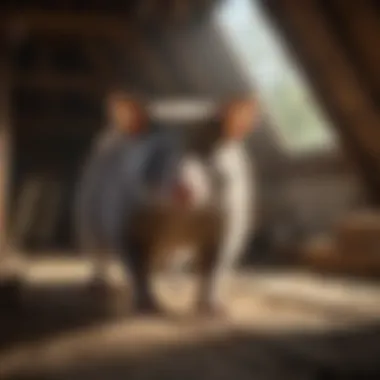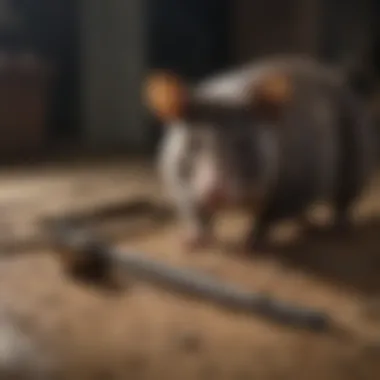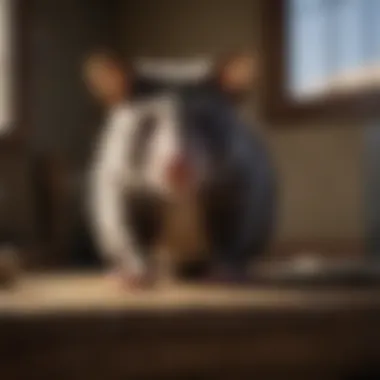Effective Ways to Safely Remove a Possum from Your House


Preventive Pest Control Strategies
When it comes to ensuring a pest-free environment in your home, implementing preventive pest control strategies is crucial. Starting with the house exterior, it is essential to seal cracks and crevices that could potentially serve as entry points for pests. Clearing debris around the perimeter of your home is another important step in deterring pests from finding shelter. Additionally, preventing pests from entering by installing screens on windows and doors can significantly reduce the chances of infestations.
Yard maintenance plays a significant role in pest prevention. It involves regular yard care routines such as mowing the lawn, trimming bushes, and removing standing water that can attract pests. Implementing methods like planting pest-repelling plants and using natural remedies can help in keeping your yard pest-free.
Maintaining indoor cleanliness is vital for keeping pests at bay. Utilizing expert cleaning tips and techniques to remove crumbs, food spills, and clutter can discourage pests from settling in your home. Creating a pest-resistant indoor environment through proper storage of food and elimination of potential hiding spots is essential.
Proper garbage disposal is a fundamental aspect of pest prevention. Efficient waste disposal methods, such as using sealed trash bins and scheduling regular garbage pickups, prevent pests from being attracted to your property. Emphasizing the importance of proper garbage disposal to reduce odors and eliminate pest feeding grounds is key to a pest-free home.
Innovative pest prevention strategies go beyond traditional methods. Utilizing technology like ultrasonic pest repellents, installing motion-activated sprinkler systems, and using organic pesticides can offer additional layers of protection against pests.
Understanding Possum Behavior
Understanding possum behavior is crucial in effectively addressing possum infestations in your home. By delving into the habits and tendencies of possums, homeowners can gain valuable insights that will help them devise successful strategies for possum removal. Discovering the intricacies of possum behavior enables individuals to take the most appropriate actions to safeguard their property and well-being.
Identifying Possum Habits
Nocturnal Traits
Possums are primarily nocturnal creatures, meaning they are most active during the night. This nocturnal behavior plays a significant role in why possums may choose to infiltrate residential spaces under the cover of darkness. Their preference for nighttime excursions can lead them to seek shelter in warm and secure environments during the daylight hours, such as attics or crawl spaces. Understanding these nocturnal traits allows homeowners to anticipate possum activity patterns and implement effective mitigation strategies.
Dietary Preferences
Possums have a varied diet that primarily consists of fruits, insects, small animals, and plants. This omnivorous appetite makes them adaptable foragers, enabling them to thrive in diverse environments. By recognizing possums' dietary preferences, homeowners can eliminate potential food sources that may attract these scavengers to their properties. Understanding what possums eat is essential in curbing infestations and dissuading them from establishing residency within homes.
Preferred Nesting Spots
Possums prefer nesting in secluded and secure locations that offer protection from predators and the elements. Common nesting sites include hollow trees, brush piles, and abandoned burrows. Knowing possums' favored nesting spots can aid homeowners in identifying potential entry points and assessing the extent of a possum infestation. By understanding where possums are likely to build their dens, individuals can proactively secure vulnerable areas and prevent future incursions.


Reasons for Possum Infiltration
Seeking Shelter
One of the primary reasons possums infiltrate homes is to seek shelter from inclement weather, predators, and other threats. By understanding possums' instinctual drive to find secure refuge, homeowners can pinpoint areas of vulnerability in their properties and fortify them against potential entry. Implementing measures to deter possums seeking shelter can significantly reduce the likelihood of infestations.
Foraging for Food
Possums venture into human habitats in search of food resources to sustain themselves. Their opportunistic feeding behavior leads them to rummage through trash cans, gardens, and compost heaps in pursuit of sustenance. Identifying the food sources that attract possums is essential for preventing them from frequenting residential areas. By eliminating access to food and securing potential food outlets, homeowners can discourage possums from intruding on their properties.
Attracted to Warmth
Possums are drawn to warm and cozy environments, especially during colder seasons. The allure of warmth prompts them to explore attics, basements, and roof spaces where they can find refuge from the elements. Understanding possums' attraction to warmth encourages homeowners to seal off entry points that may provide access to these inviting spaces. By addressing sources of warmth attraction, individuals can effectively dissuade possums from making themselves at home on their premises.
Assessing the Possum Infestation
In the realm of dealing with intrusive possums, assessing the infestation is a fundamental step that cannot be underestimated. By understanding the gravity and extent of the possum invasion within your premises, you equip yourself with invaluable knowledge to tackle the situation proactively. Not only does a thorough assessment allow you to comprehend the scale of the issue, but it also aids in devising the most appropriate and effective strategies moving forward. Considerations such as potential health hazards, property damage, and safety risks underscore the critical importance of this assessment process. Identifying signs of possum presence and locating their entry points serve as foundational pillars to expeditiously and efficiently address the infestation.
Detecting Signs of Possum Presence
Scratching Noises
Scratching noises emanating from your walls or ceilings often serve as a telltale sign of a possum's presence in your dwelling. These distinct sounds, characterized by repetitive scraping or digging, not only disrupt the peace within your home but also indicate the possum's activity and movement patterns. The persistence of these noises can signify potential damage to your property as possums seek to establish nests or forage for sustenance. While disconcerting, recognizing and addressing these scratching noises promptly can prevent further intrusion and damage, making it a vital aspect of possum infestation assessment.
Droppings and Urine Smells
The presence of possum droppings and urine smells within your living space serves as another evident indicator of a possum's infiltration. The distinctive odors associated with possum waste, coupled with the unsanitary nature of their droppings, underline the urgency in detecting and remedying this aspect of the infestation. Apart from being unpleasant and unhygienic, these droppings and smells pose health risks to inhabitants, necessitating immediate attention and removal to safeguard both human health and property integrity.
Damaged Property


Visible damage to your property, such as gnawed wires, torn insulation, or scratched surfaces, signifies the destructive impact of possums within your home. Understanding the significance of these damages is crucial in assessing the level of intrusion and devising appropriate mitigation measures. Not only does damaged property indicate the presence and activity of possums, but it also underscores the urgency in addressing the infestation to prevent further harm and maintain the integrity of your residence. Recognizing and evaluating the extent of property damage is therefore a pivotal component of assessing a possum infestation.
Safe Removal Methods
Safe removal methods are a critical aspect of effectively addressing a possum infestation in your house. By focusing on humane and non-harmful techniques, this article ensures the well-being of both the possum and the homeowner. Understanding the specific elements of safe removal methods is vital in handling the situation with care and consideration. Implementing these methods not only resolves the immediate issue but also prevents harm to the possum and maintains a safe environment within the household.
Non-Harmful Deterrents
Bright Lights and Loud Noises:
Bright lights and loud noises play a key role in deterring possums from your house. Their disruptive nature interrupts the possum's comfort, prompting them to seek quieter surroundings. This method is beneficial as it offers a non-invasive approach to discourage possums without causing them harm. The unique feature of using bright lights and loud noises is their effectiveness in altering possum behavior, making them a popular choice for homeowners dealing with infestations. While this method is advantageous in repelling possums, some limitations include potential disturbances to neighbors and the need for consistent application for lasting results.
Natural Repellents:
Natural repellents provide a safe and eco-friendly option to deter possums. These repellents are derived from natural ingredients that possums find unpleasant, deterring them from entering or staying in your house. Their non-toxic nature ensures the safety of both the possum and the environment. Using natural repellents aligns with a humane approach, offering a gentle yet effective way to manage possum infestations. The unique feature of natural repellents lies in their ability to repel possums effectively while being safe for use around pets and children. However, natural repellents may require frequent reapplication to maintain their potency.
Sealing Entry Points:
Sealing entry points is a proactive approach to preventing possums from infiltrating your home. By identifying and securing vulnerable areas where possums can gain access, you create a barrier that deters them from entering. This method is beneficial as it addresses the root cause of the infestation, reducing the likelihood of future encounters. The unique feature of sealing entry points is its long-term effectiveness in preventing possum infiltration, making it a reliable choice for safeguarding your household. While sealing entry points is a valuable strategy, it may require regular inspection and maintenance to ensure ongoing protection.
Live Trapping Techniques
Using Live Traps:
Utilizing live traps is a humane method of capturing possums for relocation. These traps offer a safe and controlled way to capture the possum without causing them harm. The key characteristic of live traps is their ability to securely contain the possum until they can be safely released. This method is popular among homeowners seeking a compassionate approach to dealing with possum infestations. The unique feature of live traps is their efficiency in capturing possums without posing a threat to other wildlife or pets. However, using live traps requires regular monitoring to ensure the timely release of captured possums.
Baiting Strategies:
Implementing baiting strategies enhances the effectiveness of live traps in capturing possums. By using appealing bait that attracts possums, you increase the likelihood of successfully trapping them. The key characteristic of baiting strategies is the strategic placement of enticing bait to lure possums into the traps. This method is beneficial as it speeds up the trapping process and improves overall success rates. The unique feature of baiting strategies is their customization potential, allowing homeowners to adapt bait choices based on possum preferences. While baiting strategies are effective, they require patience and consistency in bait placement to achieve desired results.


Releasing Possum Safely:
Releasing possums safely after trapping is essential to ensuring their well-being and survival. Selecting a suitable release location away from residential areas and natural predators increases the possum's chances of survival. The key characteristic of releasing possums safely is the careful handling and transportation to minimize stress on the captured possum. This method is a popular choice for homeowners committed to the ethical treatment of wildlife. The unique feature of releasing possums safely is the positive impact it has on possum populations, promoting coexistence with humans while maintaining ecosystem balance. However, releasing possums safely requires knowledge of safe release practices and adherence to wildlife regulations.
Seeking Professional Help
Contacting Wildlife Experts:
Engaging wildlife experts for assistance ensures informed and effective handling of possum infestations. These professionals have the expertise and resources to address possum-related issues promptly and ethically. The key characteristic of contacting wildlife experts is their specialized knowledge in wildlife behavior and management, providing insight into effective removal strategies. This choice is beneficial as it reduces the burden on homeowners and guarantees a comprehensive approach to possum removal. The unique feature of wildlife experts lies in their ability to offer tailored solutions that consider the welfare of both possums and homeowners. However, seeking professional help may involve associated costs based on the extent of the infestation and required services.
Importance of Certified Removal:
The importance of certified removal services lies in the assurance of legal compliance and ethical practices. Certified professionals adhere to industry standards and regulations, ensuring safe and humane possum removal. The key characteristic of certified removal is the expertise and training that certified professionals possess, guaranteeing reliable and effective solutions. Opting for certified removal services is a popular choice for homeowners seeking professional expertise in handling possum infestations. The unique feature of certified removal services is their accountability and commitment to wildlife conservation, promoting responsible interactions with wildlife. While certified removal is advantageous, it may involve higher service costs compared to DIY methods.
Legal Considerations:
Considering legal aspects is fundamental when dealing with possum infestations to avoid legal ramifications or consequences. Understanding local wildlife protection laws and regulations is essential to ensure compliance during possum removal. The key characteristic of legal considerations is the acknowledgment of legal boundaries and responsibilities in managing wildlife on residential properties. This choice is beneficial as it prevents potential legal issues and upholds ethical standards in wildlife management practices. The unique feature of legal considerations is their role in promoting a harmonious relationship between humans and wildlife, fostering respect for wildlife rights. However, legal considerations may involve additional research and consultation with authorities to ensure adherence to legal requirements.
Preventing Future Incidents
To ensure a possum-free household in the long run, preventing future incidents is crucial. By taking proactive measures, homeowners can safeguard their property from possum infestations. This section focuses on specific elements such as repairing entry points, regular inspections, and maintaining yard cleanliness.
Securing Your Home
Repairing Entry Points:
Repairing entry points plays a pivotal role in preventing possums from gaining access to your home. This aspect involves identifying and fixing any openings or vulnerable areas that possums could use to infiltrate your space. The key characteristic of repairing entry points is its ability to fortify the first line of defense against unwanted wildlife intrusion. By sealing off entry points effectively, homeowners can minimize the risk of possums entering their premises, making it a popular choice in possum control strategies. The unique feature of repairing entry points lies in its permanence and effectiveness in deterring potential intruders. While it requires upfront effort, the advantages of repairing entry points far outweigh any disadvantages, making it a highly recommended approach in this article.
Regular Inspections:
Regular inspections are essential in maintaining a possum-free environment. By conducting thorough and periodic checks of your property, homeowners can promptly identify any signs of possum activity and address them proactively. The key characteristic of regular inspections is their preventive nature, allowing for early detection of potential possum infestations before they escalate. This proactive approach is beneficial as it helps in nipping possum problems in the bud. The unique feature of regular inspections is their ability to provide peace of mind by ensuring that your property remains secure from possum intrusions. While regular inspections require time and effort, their advantages in preventing future incidents make them a valuable component of this article.
Maintaining Yard Cleanliness:
Maintaining yard cleanliness is another vital aspect of preventing possum incidents. Keeping your yard free of debris, overgrown vegetation, and food sources discourages possums from foraging in your outdoor space. The key characteristic of maintaining yard cleanliness is its role in creating an environment that is less attractive to possums, thereby reducing the likelihood of infestations. This simple yet effective measure is a popular choice for homeowners seeking to mitigate possum-related issues. The unique feature of maintaining yard cleanliness is its ability to promote overall hygiene and safety around the property. While it requires ongoing effort, the benefits of maintaining yard cleanliness in preventing possum incidents make it a worthwhile practice mentioned in this article.



